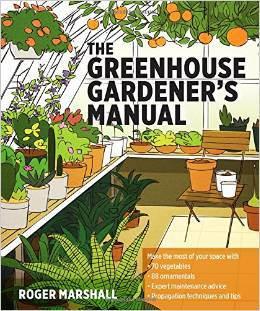
As a gardener who uses their greenhouse for more than tomatoes and annual seedlings I was interested to receive a review copy of The Greenhouse Gardener’s Manual by Roger Marshall from Timber Press. There aren’t many books on greenhouse gardening and in fact they rarely appear in the media so I thought it would be interesting to see if the author brought a different approach.
The book is fairly accessible and covers all the aspects of having a greenhouse you would expect – different types, where to locate, how to heat, ventilate, and water and recommendations on what equipment or layout you should consider. I have one quibble with the recommendations on staging which proposes slatted benches as the best option. I dispute this as my experience is that you have to be very careful what you put under the slats. If like me you have trays of seedlings you are trying to accommodate in a tiny space then having an area where any seed trays will be subject to large plops of runoff from the shelf above is not great. Although, of course, the author has a very large greenhouse so this isn’t such a consideration.
However what I found more interesting than the run of the mill setting up your greenhouse stuff and the propagation advice was the sections on the different uses you can put your greenhouse to. There is the expected vegetable and fruit growing uses but also a significant section on using your space for growing orchids which is fascinating especially to someone, like me, who is incapable of making even Moth Orchids reflower. Also interesting were the cactus and succulents and bromeliads. I wasn’t so convinced by the section on herbs as I was surprised at the idea of growing rosemary and bay in the greenhouse but I suppose if you are in certain parts of the US with very long winters then this might be more normal to you. What was very unusual and unexpected was a section on growing plants without soil, hydroponics, which goes into enough detail to give any one interested in this a good start.
The section that really interested me were the ornamentals, either flower or foliage, and a good selection were included ranging from bulbs through to shrubs such as Gardenias. The range of plants included and the advice on looking after them under glass would make this an interesting book for someone who wanted to use their conservatory for plants.
As you would expect there is a section at the back of the book on pests and diseases, some of which are illustrated although personally I would l have liked to see more photographs of these as they are quite hard to identify for the novice.
Overall I think this is a good book for someone who is thinking about investing in a greenhouse but even more so for someone who already has a greenhouse which seems to sit empty for a significant part of the year when the tomatoes have gone over. The range and diversity of plants that can be grown and give you something to enjoy during the winter, whether edible or ornamental, is often underestimated. The Greenhouse Gardener’s Manual certainly makes you consider alternatives and is well worth a read.

